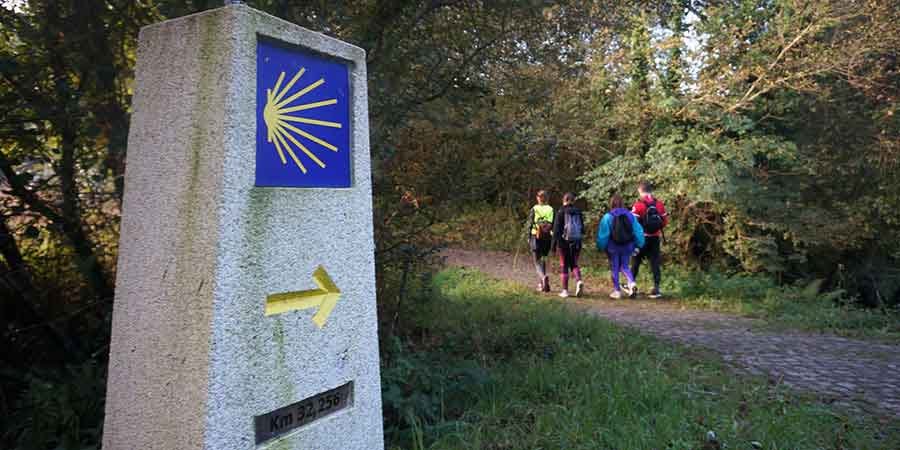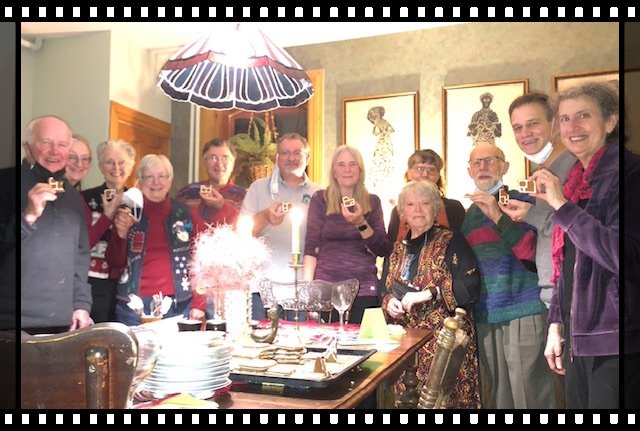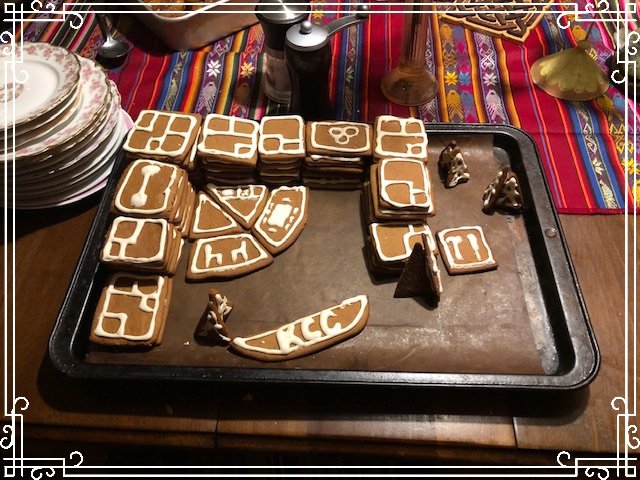El Camino Contemplation
El Camino Contemplation
-Erika Steinhubl
Clang, clang...I open my eyes to see a large cow walking nearby, her cowbell announcing her arrival. I am lying on the grass beside the yellow brick road that makes up this part of the Camino, fellow pilgrims calling out “Ultreia”, the onward encouragement, as they hike by, eager to get to the next village to stop for the night at a hostel. I had taken a mid-afternoon nap under an almond tree in bloom, a most heavenly scent. All my senses are awakened on the Camino with bells announcing the hour in the villages and the cowbells, the rhythmical swish of shoes hitting the path and tap of pilgrims hiking with walking sticks, blossoms of olives and almonds to scent the air in fields followed by the scent of cooking in the villages.
In 2001, my daughter Aurora was an au-pair for a family in Lyon, France. Touring around Spain with her before she came home, we encountered a yellow brick road marked with a scallop shell and occasional hikers in odd places. This was my introduction and pursuit of the Camino de Santiago, a 795 km trail from St-Jean-Pied-de-Port in the Pyrenees to Santiago de Compostela near the Atlantic coast.
Over the next decade I read several books about it, attended a meeting of Confraternity of St James in Toronto and dared myself to embark on this pilgrimage. When nurses at PRHC were given pedometers one year, I realized I was walking 10,000 steps daily and booked my initial foray.
Landing in Madrid in April 2009, I left my suitcase in an airport locker -- I was going to visit cousins in Germany after the two-week hike. I boarded a bus to the foot of the Pyrenees with a 20-pound backpack. I got off at the town of Roncesvalles at a thousand meters height, where I procured my pilgrim passport (Credencial Del Peregrino) and scallop shell announcing to all that I am a pilgrim. Each day I walked 20-30km, rising at dawn with others in the hostel/albergue, stopping for meals in the villages along the way. Walking ended when I was tired and found room at a hostel. Villages, located every 5-10km, all had hostels and water faucets along the way providing potable water. The path was well marked with either the stylized scallop shell of St James or the yellow painted arrow at every turn. The villagers valued the pilgrims who covered the route on foot, donkey, bike and wheelchair, as they contributed to the local economy. When pilgrims reached the hostel, they paid the 7 Euro fee for a bunk bed which included shower and kitchen use.
If so inclined, you paid 10 Euros for the pilgrim dinner at surrounding restaurants which included soup, main and a litre of good Rioja wine. My most memorable stay was outside Pamplona in the Romanesque church of San Miguel in Cizur Menor constructed in 1182 under the aegis of the Knights of Malta. The hostel was full so they gave us mattresses to lie on that ancient stone floor of the church. One pilgrim had a guitar and played folk songs followed by serenading melodies. The Knights of Malta, a religious order of laity, still provide the hospitality to pilgrims in that town.
The next day, I hiked over the Alto Del Perdon at 750 meters height, a long steep slog with no trees and a gorgeous view at the top. Wind generators atop the hill provide electricity for Pamplona. The hike down the mountain to Puente la Reina was worse than the hike to the peak and I arrived at 9pm, exhausted. I boarded a bus for Madrid, having covered less than 100 km of my journey. I had encountered no one who spoke English, which encouraged me to return. I met Germans, French, Spaniards, Italians and Indians walking the Camino for many reasons: because they were between jobs and wanted to consider what to do next, had ended a relationship and were looking for a new partner or did it for fitness, trying to go the longest distance in the shortest time. None did it for the original reason the Camino was developed, namely, to buy indulgences from the Church of Rome to ensure one’s admission into heaven after death.
In 2011, I started off mid-June in Puente la Reina and managed to cover 200 km to Burgos in ten days. There were several steep mountains to conquer as well as the daily walking meditation for 8-10 hours, many on the old Roman road, followed by well-earned sleep. Since I am a slow walker I mostly travelled alone. Fellow hikers would pace me when they were tired, unwilling to sit down because they knew they wouldn’t get up. When they were ready to hit their stride, they took off and left me behind. Some of the albergues were converted castles or former monasteries. In some villages, pilgrims shared the road with herds of cattle, and farmers still scythe their grain.
My final leg of the hike was completed in 2013. I felt this would be the last time I’d get to complete the pilgrimage so I’d have to cheat. Starting in Burgos, I took a bus to Leon where I became a tourist, using a Hop-on bus to see the sights, and attended a heavenly organ concert at the Leon cathedral. I took regional buses from Leon to Sarria to begin the final leg of the pilgrimage at km 111.
The last hundred kilometres are the worst, as many people walk just that final section in order to get the coveted Compostela on one’s passport. Consequently, the paths are wide with large groups of people often playing loud radios and singing. They pay no attention to their surroundings and scare away the birds. They are young, walk briskly, wear colourful clothes and runners and carry no knapsack. The true pilgrims, who have hiked from the Pyrenees, walk slowly, wearing beige or grey and sensible shoes and backpacks. But I make it to the cathedral and soon have my Compostela in hand. I don’t attend the noon mass but head to the bus station to return to Madrid and get on with the rest of my holiday. It’s an epicurean ten-day tour of Galicia and Barcelona curated by McGill University, the perfect ending for the trek. I loved Barcelona so much that I rented an apartment there for two months the following winter, intending to practice for retirement.
My take away from the years of being on the pilgrimage was to be present and enjoy the moment!
Delicious Cohousing
-Myra Hirschberg
At the holiday party for KCC at the Slavin’s during the last week of December, we got to see the first 3-D model of what KCC might look like, complete with common kitchen, dining, and sitting areas, exercise room, workshop, and a choice of three unit sizes. Oh yes, and we also got to eat the first 3-D model, thanks to Tom Calwell, whose home-baked gingerbread tasted as good as it looked. Here are some photos of the event (including two different configurations of the building). And thanks, too, go to Linda and Al for hosting a lovely gathering in their beautiful home.
Night and Day
-submitted by Linda Herold
An old rabbi once asked his pupils how they could tell when the night
had ended and the day had begun. “Could it be,” asked one of the
students, “when you can see an animal in the distance and tell whether
it’s a sheep or a dog?”
“No,” answered the Rabbi.
Another asked, “Is it when you can look at a tree in the distance and
tell whether it’s a fig tree or a peach tree?”
“No,” answered the Rabbi.
“Then what is it?” the pupils demanded.
“It is when you can look on the face of any man or woman and see that
it is your sister or brother. Because if you cannot see this, it is
still night.”
Introducing… Therese Kirrane
I guess I would describe Therese as intellectually curious with an adventurous spirit. Whenever life gave her the opportunity to live somewhere new, she took it. After a certain point, Therese applied for jobs or education that she had no background in and always got it. She must do a very impressive interview!
Therese was born in Walthamstow, England, a small town east of London. Her parents were Irish from county Mayo. They had their own business running a garage. She still loves the smell of a garage: spilled motor oil, gasoline, exhaust fumes. She is the oldest child of 5, having 2 brothers and 2 sisters. The youngest currently lives in Hong Kong, the other 3 live near her father in Essex. Her mother passed away in 2016 and she still feels that lack.
She left Walthamstow in 1985 to go to a university in the north of England to study Physics and Astronomy. She was a great science fiction reader (and really wanted to be an astronaut). She did her Masters in Radio Astronomy at an observatory affiliated with the University of Manchester.
Therese got her first job as an astronomer at the Royal Observatory in Edinburgh. Unfortunately, she found the civil service suffocating and couldn’t wait to leave. After 2 years there, she decided to seek her fortune with her then-boyfriend in the US. They did a 6-month cross-country road trip by Greyhound bus. After finding a good deal of superficiality in thinking and living, they decided not to stay. Once back in England, they broke up anyway, so just as well.
Back in England, she saw an advertisement for a technical writer, writing manuals for users of various equipment and software. She bluffed her way in on the strength of her Master’s thesis and some educational materials written at the Royal Observatory. She loved the job, learning about scientific analytical instruments used in forensics, hospitals and food science.
After 2 years, Therese changed jobs to the Santa Cruz Operation in Watford, just north of London, writing manuals for Unix and Xenix software. She met Sunil because they both worked in the company. I can see the start of their relationship as a rom-com movie. The company was a young one and they all went out after work to socialize. In a dark basement restaurant, she was sitting down a long table and noticed Sunil at the other end because his hair was on fire. (Not flames, but smouldering red. He had very long hair and everyone smoked everywhere in those days.) She watched, fascinated, as no one around him noticed, and when he did, he just snuffed it out and kept talking. That made her laugh. They met in the cafeteria a few times. He decided to ask her out to a movie and she said, “Sure, who else is coming?” His face fell a bit and told her it was just them. Oops. They got to the cinema and found he had no money on him and that the movie wasn’t playing that night! So they went to a pub and talked for 3 hours. End scene. Sunil had previously applied to move to the Santa Cruz office in California, and shortly after their relationship started, he had the opportunity to go. They conducted a long-distance relationship for about 6 months. When they decided to get more serious, he returned to England.
They wanted to move in together, but Therese’s Irish Catholic mother said, “If my daughter is good enough to live with, she’s good enough to marry.” His family wanted marriage too, so they had a Catholic wedding one week and a Hindu one the next, in 1991.
Sunil got a job in Manchester and Therese decided she wanted to do her PhD in Applied Philosophy – specifically, the ethics of the mainstream school systems. Why that? Therese said she had a bad experience in the education system – they force kids to specialize too early and she had to drop many interesting courses to do that, and on a global level, the system actively reinforces the status quo. She applied at the University of Manchester and met her wonderful, renegade supervisor, who agreed to take her on despite her lack of a philosophy background. Both Sunil and Therese’s children – a girl and, 2 years later, a boy -- were born here. She stayed home with the kids. (who are now 26 and 24).
Therese went back to tech writing, working for ARM. They seconded her to France, living midway between Nice and Cannes. Sunil could work from home, so the whole family moved. Because the company was English, that language was used in work, but they spoke French on breaks and at lunch. Therese says she is not as fluent as she once was and does not understand the Quebecois French -- du tout. While there her son was diagnosed with a condition called Henoch-Schonlein purpura. He needed a lot of care and suddenly work didn’t seem so important anymore. She applied for voluntary redundancy and they moved back to England.
They had loved France and decided to look for a similar, community-led environment with easy access to the sea. They moved to Cornwall and got involved in lots of community work; including school governance and the PTA, and she was a founding member of a community gardens land trust. The primary school was perfect, with only 80 pupils in total, and had a real community atmosphere.
Sunil’s company was bought out by Blackberry, who did not like work-from-home, and told him he would have a job in Canada if he wanted to stay with the company. It was good timing because their daughter was starting high school in the next town and her skin colour was becoming an issue in this mostly homogenous white area. Nobody ever let her forget she had a brown face. She’d had some disturbing comments, even from her friends. They moved to Ottawa in 2011, and her daughter’s school looks like the UN. “It was the best move we ever made.” Aside from family, there is very little else she would return to England for.
Therese absolutely loves to camp. She says she needs someone to teach her to paddle and I’m sure we can find more than one KCC member who can do that! She also loves to garden. She bakes (and eats). She reads all genres and really likes detective novels. “A nice cozy Agatha Christie-type murder where nobody needs to work and the worst thing that happens is there’s no homemade jam for tea.” She did knit for a while and is learning to quilt. She would love to learn woodworking and try dragon boating – she was on a rowing team in Cornwall.
She has known about cohousing since living in England. She googled cohousing here and found KCC. They want to be close to Toronto, as their daughter works there. They found that other communities were not as far along, nor as organized and cohesive as KCC.






